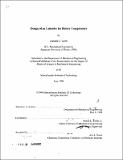| dc.contributor.advisor | Joseph L. Smith, Jr. | en_US |
| dc.contributor.author | Tarraf, Danielle C. (Danielle Charles), 1974- | en_US |
| dc.contributor.other | Massachusetts Institute of Technology. Dept. of Mechanical Engineering. | en_US |
| dc.date.accessioned | 2009-10-01T16:01:36Z | |
| dc.date.available | 2009-10-01T16:01:36Z | |
| dc.date.copyright | 1998 | en_US |
| dc.date.issued | 1998 | en_US |
| dc.identifier.uri | http://hdl.handle.net/1721.1/47905 | |
| dc.description | Thesis (S.M.)--Massachusetts Institute of Technology, Dept. of Mechanical Engineering, 1998. | en_US |
| dc.description | Includes bibliographical references (p. 139). | en_US |
| dc.description.abstract | The capacity of rolling piston type rotary compressors is typically varied by using variable speed motor drives. That entails the use of high cost electronics. This study explores an alternative means of achieving variable capacity while keeping motor speed constant, by lifting the vane intermittently. The new technique should deliver comparable system performance and efficiency at lower initial costs in order to be competitive. The thesis starts by analyzing the kinematics and dynamics of the vane motion using simplified working models of the system. Also, the interaction between the vane and the rolling piston is modeled, with focus on possible impact between the moving parts. Next, the functional requirements for a vane lifting mechanism are set. The details of the design are worked out, and a complete set of engineering drawings is fully developed. A prototype of the mechanism was constructed; a brief description of the process is given. The last part of the thesis presents the experimental work done to prove the success of the concept, to assess the mechanism, and to determine optimal operation modes. The prototype is shown to fulfill its goal of varying system capacity. The weaknesses of the design are pointed out. Some effort is made to single out the parameters that set optimal cycling times. The main findings of the experiments are presented in a brief conclusion. Recommendations are made for second generation mechanism designs and for developing criteria for cycle time optimization. | en_US |
| dc.description.statementofresponsibility | by Danielle C. Tarraf. | en_US |
| dc.format.extent | 148 p. | en_US |
| dc.language.iso | eng | en_US |
| dc.publisher | Massachusetts Institute of Technology | en_US |
| dc.rights | M.I.T. theses are protected by
copyright. They may be viewed from this source for any purpose, but
reproduction or distribution in any format is prohibited without written
permission. See provided URL for inquiries about permission. | en_US |
| dc.rights.uri | http://dspace.mit.edu/handle/1721.1/7582 | en_US |
| dc.subject | Mechanical Engineering. | en_US |
| dc.title | Design of an unloader for rotary compressors | en_US |
| dc.title.alternative | Unloader for rotary compressors | en_US |
| dc.type | Thesis | en_US |
| dc.description.degree | S.M. | en_US |
| dc.contributor.department | Massachusetts Institute of Technology. Department of Mechanical Engineering | |
| dc.identifier.oclc | 48198258 | en_US |
